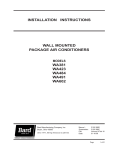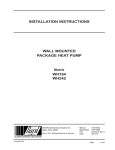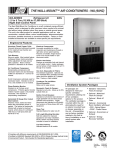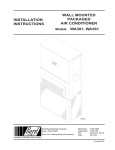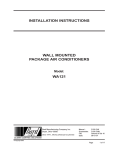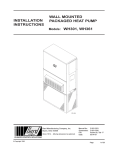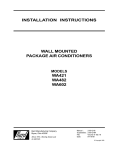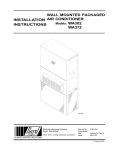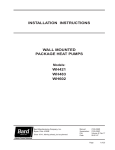Download Bard W24L2 Specifications
Transcript
INSTALLATION INSTRUCTIONS WALL MOUNTED PACKAGED AIR CONDITIONER Models: WA182, WA242 Bard Manufacturing Company, Inc. Bryan, Ohio 43506 Since 1914...Moving ahead just as planned © Copyright 2002 Manual No.: Supersedes: File: Date: 2100-369E 2100-369D Volume III, Tab 16 08-01-07 Manual Page 2100-369E 1 of 18 CONTENTS Getting Other Information and Publications .......... 3 For more information, contact these publishers .......................................... 3 Wall Mount General Information ............................. Air Conditioner Wall Mount Model Nomenclature .... Shipping Damage .................................................... General .................................................................... Duct Work ................................................................ Filters ....................................................................... Fresh Air Intake ....................................................... Condensate Drain .................................................... 4 4 7 7 7 7 8 8 Installation Instructions ........................................... Wall Mounting Information ....................................... Mounting the Unit .................................................... Wiring — Main Power .............................................. Wiring — Low Voltage Wiring .................................. 9 9 9 9 9 Figures Figure 1 Figure 2 Figure 3 Figure 4 Figure 5 Figure 6 Figure 7 Figure 8 Figure 9 Unit Dimensions ..................................... 5 Blower Damper Assembly ...................... 8 Mounting Instructions ........................... 10 Wall-Mounting Instructions .................... 11 Wall-Mounting Instructions .................... 11 Common Wall-Mounting Installations ... 12 Low Voltage Wiring .............................. 13 Start Up Label ...................................... 14 Fan Blade Setting ................................. 16 Start Up ................................................................... Important Installer Note ......................................... Crankcase Heaters ................................................ Service Hints ......................................................... Sequence of Operation .......................................... Compressor Control Module .................................. Adjustments ........................................................... Pressure Service Ports .......................................... 14 14 14 14 14 14 15 15 Troubleshooting ..................................................... Fan Blade Setting Dimensions .............................. Removal of Fan Shroud ......................................... Refrigerant Charge ................................................ Optional Accessories ............................................. 16 16 16 16 18 Tables Table 1 Table 2 Table 3 Table 4 Table 5 Table 6 Table 7 Table 8 Table 9 Table 10 Table 11 Manual 2100-369E Page 2 of 18 Electric Heat Table ................................. Electrical Specifications ......................... Thermostat Wire Size ............................. Wall Thermostat ..................................... Fan Blade Dimensions ......................... Suction Line Temperatures .................. Indoor Blower Performance ................. CFM and ESP ...................................... Maximum ESP of Operation Electric Heat Only ................................ Cooling Pressure .................................. Optional Accessories ........................... 4 6 9 9 16 16 16 17 17 17 18 Getting Other Information and Publications These publications can help you install the air conditioner or heat pump. You can usually find these at your local library or purchase them directly from the publisher. Be sure to consult current edition of each standard. For more information, contact these publishers: ACCA Air Conditioning Contractors of America 1712 New Hampshire Avenue NW Washington, DC 20009 Telephone: (202) 483-9370 Fax: (202) 234-4721 ANSI American National Standards Institute 11 West Street, 13th Floor New York, NY 10036 Telephone: (212) 642-4900 Fax: (212) 302-1286 National Electrical Code ...................... ANSI/NFPA 70 Standard for the Installation ............... ANSI/NFPA 90A of Air Conditioning and Ventilating Systems Standard for Warm Air ....................... ANSI/NFPA 90B Heating and Air Conditioning Systems Load Calculation for ............................ ACCA Manual J Residential Winter and Summer Air Conditioning Duct Design for Residential ............... ACCA Manual D Winter and Summer Air Conditioning and Equipment Selection ASHRAE American Society of Heating Refrigerating, & Air Conditioning Engineers, Incorporated 1791 Tullie Circle, N.E. Atlanta, GA 30329-2305 Telephone: (404) 636-8400 Fax: (404) 321-5478 NFPA National Fire Protection Association Batterymarch Park P.O. Box 9101 Quincy, MA 02269-9901 Telephone: (800) 344-3555 Fax: (617) 984-7057 Manufactured under the following U.S. patent numbers: 5,485,878; 5,301,744; 5,002,116; 4,924,934; 4,875,520; 4,825,936 Manual Page 2100-369E 3 of 18 WALL MOUNT GENERAL INFORMATION Air Conditioner Wall Mount Model Nomenclature WA MODEL NUMBER 24 2 A 10 X X X X A CONTROL MODULES KW REVISIONS COLOR OPTIONS X - Beige (Standard) 1 - White 2 - Mesa Brown 4 - Buckeye Gray 5 - Desert Brown 6 - Dark Bronze VOLTS & PHASE A - 230/208/60/1 B - 230/208/60/3 C - 460/60/3 CAPACITY 18 - 1½ Ton 24 - 2 Ton X VENTILATION OPTIONS X - Barometric Fresh Air Damper (Standard) B - Blank-off Plate M - Motorized Fresh Air Damper V - Commercial Room Ventilator - Motorized with Exhaust E - Economizer (Internal - Fully Modulating w/Exhaust) R - Energy Recovery Ventilator - with Exhaust FILTER OPTIONS X - One Inch Throwaway (Standard) W - One Inch Washable P - Two Inch Pleated COIL OPTIONS X - Standard 1 - Phenolic Coated Evaporator 2 - Phenolic Coated Condenser 3 - Phenolic Coated Evaporator and Condenser OUTLET OPTIONS X - Front (Standard) T - Top on WA30 & WA36 Models NOTE: For 0KW & circuit breakers (230/208 Volt) or pull disconnect (460 Volt) applications, insert 0Z in the KW field of model number. TABLE 1 ELECTRIC HEAT TABLE Models WA182-A 240V-1 KW WA242-A 208V-1 240V-1 WA242-B 208V-1 240V-3 WA242-C 208V-3 AMPS BTUH AMPS BTUH AMPS BTUH AMPS BTUH AMPS BTUH AMPS BTUH 4 16.7 13,650 14.4 10,240 5 20.8 17,065 18.1 12,800 20.8 17,065 18.1 12,800 8 33.3 27,300 28.8 20,475 33.3 27,300 28.8 20,475 10 41.6 34,130 36.2 25,600 41.6 34,130 36.2 25,600 6.0 14.4 20,500 12.5 15,360 9.0 21.7 30,600 18.7 23,030 Manual 2100-369E Page 4 of 18 460 AMPS B TU H 7.2 20,500 Manual Page 2100-369E 5 of 18 Depth Height (D) (H) B C A B Return Supply E F G I J K L M N O P Q R S T FRONT VIEW * Optional top outlet (factory installed only) for WA30 and WA36 models only. SIDE VIEW BACK VIEW WA18 33.300 17.125 70.563 7.88 19.88 11.88 19.88 35.00 18.50 25.75 20.56 26.75 28.06 29.25 27.00 2.63 34.13 22.06 10.55 4.19 12.00 5.00 WA24 Width Model (W) UNIT DIMENSIONS FIGURE 1 TABLE 2 ELECTRICAL SPECIFICATIONS SINGLE CIRCUIT 3 Model Rated Volts & P h ase N o. Field P o w er Circuits 1 2 2 Maximum External Minimum Fuse or Field Circuit Circuit P o w er Ground Ampacity Breaker Wire Siz e Wire Siz e WA182-A00, A0Z A 05 230/208-1 A 08 A 10 1 1 1 1 16 30 45 56 20 30 45 60 12 10 8 6 12 10 10 10 WA242-A00, A0Z A 04 A05 230/208-1 A 08 A 10 1 1 1 1 1 17 24 30 45 56 20 25 30 45 60 12 10 10 8 6 12 10 10 10 10 WA242-B00, B0Z 230/208-3 B 06 1 1 13 22 15 25 14 10 12 10 WA242-C00, C0Z C 06 1 1 8 11 15 15 14 14 14 14 460-3 460-3 1 Maximum size of the time delay fuse or HACR type circuit breaker for protection of field wiring conductors. 2 Based on 75° copper wire. All wiring must conform to the National Electrical Code and all local codes. 3 These “Minimum Circuit Ampacity” values are to be used for sizing the field power conductors. Refer to the National Electric Code (latest revision), Article 310 for power conductor sizing. CAUTION: Manual 2100-369E Page 6 of 18 When more than one field power conductor circuit is run through one conduit, the conductors must be derated. Pay special attention to note 8 of table 310 regarding Ampacity Adjustment Factors when more than three conductors are in a raceway. SHIPPING DAMAGE Upon receipt of equipment, the carton should be checked for external signs of shipping damage. If damage is found, the receiving party must contact the last carrier immediately, preferably in writing, requesting inspection by the carrier’s agent. GENERAL The equipment covered in this manual is to be installed by trained, experienced service and installation technicians. Refer to Table 9 for maximum static pressure available for duct design. Design the duct work according to methods given by the Air Conditioning Contractors of America (ACCA). When duct runs through unheated spaces, it should be insulated with a minimum of 1-inch insulation. Use insulation with a vapor barrier on the outside of the insulation. Flexible joints should be used to connect the duct work to the equipment in order to keep the noise transmission to a minimum. The refrigerant system is completely assembled and charged. All internal wiring is complete. A 1/4 inch clearance to combustible material for the first 3 feet of duct attached to the outlet air frame is required. See Wall Mounting Instructions and Figures 3, 4, 5 and 6 for further details. The unit is designed for use with or without duct work. Flanges are provided for attaching the supply and return ducts. Ducts through the walls must be insulated and all joints taped or sealed to prevent air or moisture entering the wall cavity. These instructions explain the recommended method to install the air cooled self-contained unit and the electrical wiring connections to the unit. These instructions and any instructions packaged with any separate equipment required to make up the entire air conditioning system should be carefully read before beginning the installation. Note particularly “Starting Procedure” and any tags and/or labels attached to the equipment. While these instructions are intended as a general recommended guide, they do not supersede any national and/or local codes in any way. Authorities having jurisdiction should be consulted before the installation is made. See Page 3 for information on codes and standards. Size of unit for a proposed installation should be based on heat loss calculation made according to methods of Air Conditioning Contractors of America (ACCA). The air duct should be installed in accordance with the Standards of the National Fire Protection Association for the Installation of Air Conditioning and Ventilating Systems of Other Than Residence Type, NFPA No. 90A, and Residence Type Warm Air Heating and Air Conditioning Systems, NFPA No. 90B. Where local regulations are at a variance with instructions, installer should adhere to local codes. DUCT WORK All duct work, supply and return, must be properly sized for the design airflow requirement of the equipment. Air Conditioning Contractors of America (ACCA) is an excellent guide to proper sizing. All duct work or portions thereof not in the conditioned space should be properly insulated in order to both conserve energy and prevent condensation or moisture damage. CAUTION Some installations may not require any return air duct. A metallic return air grille is required with installations not requiring a return air duct. The spacing between louvers on the grille shall not be larger than 5/8 inches. Any grille that meets the 5/8 inch louver criteria may be used. It is recommended that Bard Return Air Grille Kit RG-2 through RG-5 or RFG-2 through RFG-5 be installed when no return duct is used. Contact distributor or factory for ordering information. If using a return air filter grille, filters must be of sufficient size to allow a maximum velocity of 400 fpm. NOTE: If no return air duct is used, applicable installation codes may limit this cabinet to installation only in a single story structure. FILTERS A 1-inch throwaway filter is suppled with each unit. The filter slides into position making it easy to service. This filter can be serviced from the outside by removing the service door. A 1-inch washable filter and a 2-inch pleated filter are also available as optional accessories. The internal filter brackets are adjustable to accommodate the 2-inch filter by loosening 2 screws in each bracket assembly and sliding the brackets apart to the required width and retightening the 4 screws. Manual Page 2100-369E 7 of 18 FRESH AIR INTAKE CONDENSATE DRAIN All units are built with fresh air inlet slots punched in the service panel. A plastic drain hose extends from the drain pan at the top of the unit down to the unit base. There are openings in the unit base for the drain hose to pass through. In the event the drain hose is connected to a drain system of some type, it must be an open or vented type system to assure proper drainage. If the unit is equipped with the fresh air damper assembly, the assembly is shipped already attached to the unit. The damper blade is locked in the closed position. To allow the damper to operate, the maximum and minimum blade position stops must be installed. See Figure 2. All capacity, efficiency and cost of operation information as required for Department of Energy “Energyguide” Fact Sheets is based upon the fresh air blank-off plate in place and is recommended for maximum energy efficiency. FIGURE 2 FRESH AIR DAMPER ASSEMBLY The blank-off plate is available upon request from the factory and is installed in place of the fresh air damper shipped with each unit. LOW VOLTAGE CONNECTIONS These units use a grounded 24 volt AC low voltage circuit. LOW VOLTAGE CONNECTIONS FOR DDC CONTROL Fan Only Energize G The "R" terminal is the hot terminal and the "C" terminal is grounded. Cooling Mode Energize Y, G "G" terminal is the fan input. 1st Stage Heating Energize W1 "Y" terminal is the compressor input for cooling. 2nd Stage Heating (if employed) Energize W1, W2 "W1" terminal is the 1st stage electric heat. The reversing valve must be energized for heating mode. Ventilation Energize G, F "W2" terminal is second stage heat (if equipped). "F" terminal is the ventilation input. This terminal energizes any factory installed ventilation option. Manual 2100-369E Page 8 of 18 INSTALLATION INSTRUCTIONS WALL MOUNTING INFORMATION WIRING — MAIN POWER 1. These units are secured by wall mounting brackets which secure the unit to the outside wall surface at both sides. A bottom mounting bracket is provided for ease of installation, but is not required. 2. On wood-frame walls, the wall construction must be strong and rigid enough to carry the weight of the unit without transmitting any unit vibration. Refer to the unit rating plate for wire sizing information and maximum fuse or “HACR Type” circuit breaker size. The disconnect access door on this unit may be locked to prevent unauthorized access to the disconnect. To convert for the locking capability, bend the tab located in the bottom left hand corner of the disconnect opening under the disconnect access panel straight out. This tab will now line up with the slot in the door. When shut, a padlock may be placed through the hole in the tab preventing entry. 3. Concrete block walls must be thoroughly inspected to insure that they are capable of carrying the weight of the installing unit. MOUNTING THE UNIT 1. Two holes, for the supply and return air openings, must be cut through the wall as shown in Figure 3. 2. Locate and mark lag bolt locations and bottom mounting bracket location, if desired. See Figure 3. WIRING — LOW VOLTAGE WIRING 230/208V, 1 phase and 3 phase equipment dual primary voltage transformers. All equipment leaves the factory wired on 240V tap. For 208V operation, reconnect from 240V to 208V tap. The acceptable operating voltage range for the 240 and 208V taps are: OPERATING VOLTAGE RANGE 3. Mount bottom mounting bracket, if used. 4. Hook top rain flashing under back bend of top. Top rain flashing is shipped attached to the back of the unit on the right side. 5. Position unit in opening and secure with 5/16 lag bolts; use 7/8 inch diameter flat washers on the lag bolts. 6. Secure rain flashing to wall and caulk across entire length of top. See Figure 3. 7. For additional mounting rigidity, the return air and supply air frames or collars can be drilled and screwed or welded to the structural wall itself (depending upon wall construction). Be sure to observe required clearance if combustible wall. 8. On side-by-side installations, maintain a minimum of 20 inches clearance on right side to allow access to heat strips and control panel and to allow proper airflow to the outdoor coil. Additional clearance may be required to meet local or national codes. THERMOSTAT WIRE SIZE 55 RANGE 240V 253 - 216 208V 220 - 187 NOTE: The voltage should be measured at the field power connection point in the unit and while the unit is operating at full load (maximum amperage operating condition.) Five (5) wires should be run from thermostat subbase to the 24V terminal board in the unit. A five conductor, 18 gauge copper, color-coded thermostat cable is recommended. The connection points are shown in Figure 7. TABLE 4 WALL THERMOSTAT Thermostat Predominate Features 1 stage Cool, 1 stage Heat 8403-057 Electronic Non-Programmable TH5220D1153 Auto or Manual changeover TABLE 3 Transformer VA TAP FLA Wire Gauge Maximum Distance In Feet 2.3 20 gauge 18 gauge 16 gauge 14 gauge 12 gauge 45 60 100 160 250 2 stage Cool, 2 stage Heat 8403-058 Electronic Non-Programmable TH5220D1151 Auto or Manual changeover 8403-060 (1120-445) 3 stage Cool; 3 stage Heat Programmable/Non-Programmable Electronic HP or Conventional Auto or Manual changeover Manual Page 2100-369E 9 of 18 Manual 2100-369E Page 10 of 18 FIGURE 3 MOUNTING INSTRUCTIONS FIGURE 4 WALL-MOUNTING INSTRUCTIONS SEE FIGURE 3 – MOUNTING INSTRUCTIONS FIGURE 5 WALL-MOUNTING INSTRUCTIONS SEE UNIT DIMENSIONS, FIGURE 1, FOR ACTUAL DIMENSIONS SEE FIGURE 1 FOR DUCT DIMENSIONS Manual Page 2100-369E 11 of 18 FIGURE 6 COMMON WALL-MOUNTING INSTALLATIONS Manual 2100-369E Page 12 of 18 FIGURE 7 LOW VOLTAGE WIRING Manual Page 2100-369E 13 of 18 START UP IMPORTANT INSTALLER NOTE For improved start-up performance, wash the indoor coil with a dishwasher detergent. CRANKCASE HEATERS All units are provided with some form of compressor crankcase heat. All single and three phase models have an insertion welltype heater located in the lower section of the compressor housing. This is a self-regulating type heater that draws only enough power to maintain the compressor at a safe temperature. Some form of crankcase heat is essential to prevent liquid refrigerant from migrating to the compressor, causing oil pump out on compressor start up and possible valve failure due to compressing a liquid. The decal in Figure 8 is affixed to all outdoor units detailing start up procedure. This is very important. Please read carefully. SERVICE HINTS 1. Caution homeowner to maintain clean air filters at all times. Also, not to needlessly close off supply and return air registers. This reduces airflow through the system, which shortens equipment service life as well as increasing operating costs. 2. Check all power fuses or circuit breakers to be sure they are the correct rating. FIGURE 8 START UP LABEL IMPORTANT These procedures must be followed at initial start up and at any time power has been removed for 12 hours or longer. To prevent compressor damage which may result from the presence of liquid refrigerant in the compressor crankcase: 1. Make certain the room thermostat is in the "off" position (the compressor is not to operate). 2. Apply power by closing the system disconnect switch. This energizes the compressor heater which evaporates the liquid refrigerant in the crankcase. 3. Allow 4 hours or 60 minutes per pound of refrigerant in the system as noted on the unit rating plate, whichever is greater. 4. After properly elapsed time, the thermostat may be set to operate the compressor. 5. Except as required for safety while servicing, do not open system disconnect switch. 7961-061 3. Periodic cleaning of the outdoor coil to permit full and unrestricted airflow circulation is essential. SEQUENCE OF OPERATION Cooling—Circuit R-Y makes at thermostat pulling in compressor contactor, starting the compressor and outdoor motor. The G (indoor motor) circuit is automatically completed on any call for cooling operation or can be energized by manual fan switch on subbase for constant air circulation. On all 230 volt units there is a one-minute off delay on the blower motor. 460 volt models do not have an off delay. On a call for heating, circuit R-W1 make at the thermostat pulling in heat contact for the strip heat and blower operation. On a call for second stage heat, R-W2 makes bringing on second heat contactor, if so equipped. Manual 2100-369E Page 14 of 18 COMPRESSOR CONTROL MODULE The compressor control module is optional on the models covered by this manual. The compressor control is an anti-short cycle/lockout timer with high and low pressure switch monitoring and alarm relay output. Adjustable Delay On Make And Break Timer On initial power up or anytime power is interrupted to the unit, the delay on make period begins, which will be 2 minutes plus 10% of the delay on break setting. When the delay on make is complete and the high pressure switch (and low pressure switch if employed) is closed, the compressor contactor is energized. Upon shutdown the delay or break timer starts and prevents restart until the delay on break and delay on make periods have expired. During routine operation of the unit with no power interruptions the compressor will operate on demand with no delay. High Pressure Switch and Lockout Sequence ADJUSTMENTS If the high pressure switch opens, the compressor contactor will de-energize immediately. The lockout timer will go into a soft lockout and stay in soft lockout until the high pressure switch closes and the delay on break time has expired. If the high pressure switch opens again in this same operating cycle the unit will go into manual lockout condition and the alarm relay circuit will energize. Recycling the wall thermostat resets the manual lockout. Adjustable Delay on Make and Delay on Break Timer Low Pressure Switch, Bypass, and Lockout Sequence If the low pressure switch opens for more than 120 seconds, the compressor contactor will de-energize and go into a soft lockout. Regardless the state of the low pressure switch, the contactor will reenergize after the delay on make time delay has expired. If the low pressure switch remains open, or opens again for longer than 120 seconds the unit will go into manual lockout condition and the alarm relay circuit will energize. Recycling the wall thermostat resets the manual lockout. The potentiometer is used to select Delay on Break time from 30 seconds to 5 minutes. Delay on Make (DOM) timing on power-up and after power interruptions is equal to 2 minutes plus 10% of Delay on Break (DOB) setting: 0.5 minute 1.0 minute 2.0 minute 3.0 minute 4.0 minute 5.0 minute (30 seconds) (60 seconds) (120 seconds) (180 seconds) (240 seconds) (300 seconds) DOB =123 second DOB =126 second DOB =132 second DOB =138 second DOB =144 second DOB =150 second DOM DOM DOM DOM DOM DOM During routine operation of the unit with now power interruptions the compressor will operate on demand with no delay. Typical Settings for Dual Unit Installation: Unit No. 1: DOB set at 2 minutes, and DOM is 132 sec. Unit No. 2: DOB set at 4 minutes, and DOM is 144 sec. Alarm Relay Output Alarm terminal is output connection for applications where alarm relay is employed. This terminal is powered whenever compressor is locked out due to HPC or LPC sequences as described. NOTE: Both high and low pressure switch controls are inherently automatic reset devices. The high pressure switch and low pressure switch cut out and cut in settings are fixed by specific air conditioner or heat pump unit model. The lockout features, both soft and manual, are a function of the Compressor Control Module. PRESSURE SERVICE PORTS High and low pressure service ports are installed on all units so that the system operating pressures can be observed. Pressure tables can be found later in the manual covering all models. It is imperative to match the correct pressure table to the unit by model number. Manual Page 2100-369E 15 of 18 TROUBLESHOOTING FAN BLADE SETTING DIMENSIONS REFRIGERANT CHARGE Shown in the drawing below are the correct fan blade setting dimensions for proper air delivery across the outdoor coil. The correct system R-22 charge is shown on the unit rating plate. Optimum unit performance will occur with a refrigerant charge resulting in a suction line temperature (6 inches from compressor) as shown in Table 6. Any service work requiring removal or adjustment in the fan and/or motor area will require that the dimensions below be checked and blade adjusted in or out on the motor shaft accordingly. TABLE 6 SUCTION LINE TEMPERATURES Model Rated Airflow 95 F OD Temperature 82 F OD Temperature FIGURE 9 WA182 650 51 - 53 63 - 65 FAN BLADE SETTING WA242 800 61 - 63 63 - 65 The suction line temperatures in Table 6 are based upon 80ºF dry bulb/67ºF wet bulb (50 percent R.H.) temperature and rated airflow across the evaporator during cooling cycle. TABLE 5 FAN BLADE DIMENSION Model Dimension A WA182 WA242 1.00 REMOVAL OF FAN SHROUD 1. Disconnect all power to unit. 2. Remove the screws holding both grills, one on each side of unit, and remove grills. 3. Remove screws holding fan shroud to condenser and bottom – 9 screws. 4. Unwire condenser fan motor. 5. Slide complete motor, fan blade, and shroud assembly out the left side of the unit. 6. Service motor/fan as needed. 7. Reverse steps to reinstall. Manual 2100-369E Page 16 of 18 TABLE 7 INDOOR BLOWER PERFORMANCE CFM AT 230 VOLTS WA182, WA242 230V E.S.P. In H2O Dry Coil Wet Coil .0 1020 975 .1 960 905 .2 865 800 .3 820 735 .4 735 650 .5 615 535 TABLE 8 CFM and ESP TABLE 9 MAXIMUM ESP OF OPERATION ELECTRIC HEAT ONLY 1 1 Rated ESP Recommended Airflow Range Model KW ESP Model Rated C FM WA182 650 .40 575 - 725 WA182 WA242 WA242 800 .20 700 - 950 A 00 A 05 A 08 .50 .50 .50 WA242 B 00 B 06 .50 .50 1 Rated CFM and ESP on high speed tap TABLE 10 COOLING PRESSURE – OUTDOOR TEMPERATURE °F Model WA182 WA242 Return Air Temperature Pressure 75 80 85 90 95 75 deg D B 62 deg WB Low S i de High Side 71 194 73 208 75 223 77 238 79 253 81 268 82 284 84 299 85 315 80 deg D B 67 deg WB Low S i de High Side 76 199 78 214 80 229 83 244 84 259 86 275 88 291 90 307 91 323 85 deg D B 72 deg WB Low S i de High Side 81 206 84 221 86 237 89 253 91 268 93 285 95 301 96 318 98 334 75 deg D B 62 deg WB Low S i de High Side 72 198 75 214 78 230 80 246 82 261 84 276 86 291 87 305 89 319 80 deg D B 67 deg WB Low S i de High Side 74 211 77 229 80 246 82 263 84 280 86 295 88 311 90 326 91 341 85 deg D B 72 deg WB Low S i de High Side 77 227 80 246 83 265 85 283 87 300 89 318 91 334 93 351 94 367 100 105 110 115 Low side pressure ± 2 psig High side pressure ± 5 psig Tables are based upon rated CFM (airflow) across the evaporator coil and should be found under section titled "refrigerant charge" elsewhere in manual. If there is any doubt as to correct charge being in the system, the charge should be removed, system evacuated and recharged to serial plate instructions. Manual Page 2100-369E 17 of 18 TABLE 11 WA242-C WA242-B Description WA242-A Model WA182-A OPTIONAL ACCESSORIES EHWA24-A04 Heater Packages EHWA02-A05 Heater Packages X X EHWA02A-A08 Heater Packages X X EHWA02A-A10 Heater Packages X X EHWA24-B06 Heater Packages BOP-2 Blank Off Plate X X X X BFAD-2 Barometric Fresh Air Damper X X X X MFAD-2 Motorized Fresh Air Damper X X X X CRV-2 Commercial Ventilator with Exhaust X X X X EIFM-2 Economizer with Exhaust X X X X WERV-A2B Energy Recovery Ventilator X X X X CMA-5 Time Delay Relay (TDR) X X X X CMA-6 Low Ambient Control (LAC) X X X X CMA-8 TDR + HPC X X X X CMA-10A LPC + HPC + TDR X X X X CMA-13A LPC + HPC + TDR + LAC X X X X CMC-15 Start Kit X X WMCB-02A Circuit Breaker Kit X X WMCB-01B Circuit Breaker Kit EHWA24B-C06 Heater Packages X Circuit Breaker Kit X WMPD-01C Manual 2100-369E Page 18 of 18 X X X


















